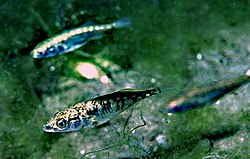Stickleback
| Stickleback | |
|---|---|

| |
| Three-spined stickleback, Gasterosteus aculeatus | |
| Scientific classification | |
| Kingdom: | |
| Phylum: | |
| Class: | |
| Subclass: | |
| Infraclass: | |
| Order: | |
| Family: | Gasterosteidae
|
| Genera | |
The Gasterosteidae are a family of fish including the sticklebacks. FishBase recognises 16 species in the family, grouped in five genera.[1] However, several of the species have a number of recognised subspecies, and the taxonomy of the family is thought to be in need of revision. Although some authorities give the common name of the family as "sticklebacks and tube-snouts", the tube-snouts are classified in the related family Aulorhynchidae.
An unusual feature of sticklebacks is that they have no scales, although some species have bony armour plates. They are related to pipefish and seahorses.
Sticklebacks are most commonly found in the ocean, but some can be found in fresh water. The freshwater taxa were trapped in Europe, Asia, and North America after the ice age, and have evolved different features from the marine species. Sticklebacks are carnivorous, feeding on small animals such as insects, crustaceans and fish larvae.[2][3]
Sticklebacks are characterised by the presence of strong and clearly isolated spines in their dorsal fins.[4] The maximum size of the best-known species, the three-spined stickleback (Gasterosteus aculeatus), is about 4 in (10 cm), but few of them are more than 3 in (7.6 cm) long. They mature sexually at a length of about 2 in (5.1 cm).[5] Most other stickleback species are roughly similar in size with the only notable exception being the far larger fifteen-spined stickleback (Spinachia spinachia).[6] All species show a similar mating behaviour, which is also unusual among fish. The males construct a nest from vegetation held together by secretions from their kidneys, then attract females to the nest. The female lays her eggs inside the nest where the male can fertilise them. The male then guards the eggs until they hatch.[3]

Stickleback (Gasterosteus aculeatus)
Faroese stamp issued: 7 Feb 1994
Artist: Astrid Andreasen
References
- ^ Froese, Rainer, and Daniel Pauly, eds. (2012). "Gasterosteidae" in FishBase. October 2012 version.
- ^ The Repeater - NYTimes.com
- ^ a b Orr, James W. & Pietsch, T.W. (1998). Paxton, J.R. & Eschmeyer, W.N. (ed.). Encyclopedia of Fishes. San Diego: Academic Press. pp. 171–172. ISBN 0-12-547665-5.
{{cite book}}: CS1 maint: multiple names: authors list (link) - ^ Widespread Parallel Evolution in Sticklebacks by Repeated Fixation of Ectodysplasin Alleles by sciencemag.org
- ^ "Three-spined stickleback". Gma.org. Retrieved 2012-08-31.
- ^ Froese, Rainer; Pauly, Daniel (eds.) (2014). "Spinachia spinachia" in FishBase. April 2014 version.
External links
- Chisholm, Hugh, ed. (1911). . Encyclopædia Britannica (11th ed.). Cambridge University Press.
- 1930 Newsreel of Stickleback Building Nest by British Pathé
